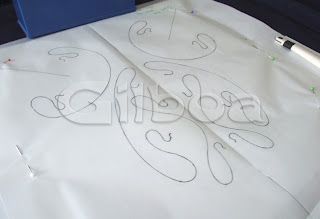Once again a brief overview, showing some of the steps involved in the making of Gilboa Flat Cap H43. Some of the pictures are slightly blurred but it will give the general idea of what is going on.
The inspiration for this hat's design came from an art nouveau door.
First the imagined design is being sketched with pencil on transparency paper and
once happy, drawn out in ink.
As the pattern starts to become more and more complicated, colour-coding helps making sense of it all later.
This is the door that was inspiration for this particular design (and there will be more).
To see if the design is workable at all, a prototype with scrap fabric is created. It is made up of 3 pieces intertwining and added pin-tucks that are 'climb' over and under.
Now lets start with the real deal:

Now the indivividual pieces (3) are being one by one transferred onto the main fabric's left hand side.

Piece number one

The traces are 'transferred' to the right side of the fabric by 'basting' stitches, marking the actual shape and the pin-tuck decoration in different colours.

That is how it looks on the fabric's right side, the stitches can later be removed without leaving any marks.

Piece number 2: same as above - transfer, trace, baste.

Piece number 2: the right side.

Piece number 2 is being prepared to be stitched onto piece number one.
The two pieces joined.
Piece number 3: again, tracing and basting.
The basting here is used for placement of the previously joined up pieces as well as marking the pin-tuck position.
All 3 pieces joined.
Seams are being cleaned up before pin-tucking.
The most time-consuming part: the pin-tucks. One by one they are stitched, rather a stop-start affair and testing one's patience. But the effect is worth it in the end!











































